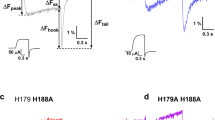Abstract
Fluorescence-optical measurements of the intracellular chloride concentration facilitate identification of chloride movements across the cell membrane of living cells. The two main dyes used for this purpose are 6-methoxy-N-(3-sulfopropyl)quinolinium (SPQ) and 6-methoxy-quinolyl acetoethyl ester (MQAE). The use of both substances is impaired by their poor membrane permeability and therefore limited loading of the cells to be studied. Here we report the use of 6-methoxy-N-ethylquinolinium iodide (MEQ), a chloride-sensitive dye for which a membrane-permeable form is easily prepared. This makes the loading procedure as easy as with the acetoxymethyl (AM) forms of other dyes for sensing intracellular ions. In addition, the original method, which described absolute concentration measurements of chloride in the cytosol, was modified in so far as only relative measurements were made. This avoids the known limitations of single wavelength excitation and emission dyes with respect to exact concentration measurements. More-over, to enhance the signal-to-noise ratio the driving force for chloride was considerably increased by changing the original direction of the anion flux in the cells under investigation. We verified the method by using fibroblasts and activating ICln, a putative chloride channel cloned from epithelial cells and of paramount importance in the regulatory volume decrease in these cells. In the presence of SCN− the MEQ quench measured in NIH 3T3 fibroblasts is dramatically enhanced in hypotonically challenged cells compared with cells under isotonic conditions. Antisense oligodeoxynucleotides sensing I Cln considerably impeded the swelling-induced chloride current (I Cl) in NIH 3T3 fibroblasts. Accordingly, the chloride movement measured by the SCN− quench of the MEQ signal was significantly reduced. Similar results can be obtained in the presence of 5-nitro-2-(3-phenylpropylamino)benzoic acid (NPPB) or 4,4′-diisothiocyanatostilbene-2,2′-disulfonic acid (DIDS), two known blockers of chloride transport in the plasma membrane of a variety of cells. In conclusion, fluroscence-optical measurements using MEQ as the chloride-sensitive dye provide a reliable and easy-to-use method for measuring changes of the chloride flux across the cell membrane of living cells.
Similar content being viewed by others
References
Biwersi J, Verkman AS (1991) Cell-permeable fluorescent indicator for cytosolic chloride. Biochemistry 30: 7879–7883
Bubien JK, Kirk KL, Rado A, Frizzell RA (1990) Cell cycle dependence of chloride permeability in normal and cystic fibrosis lymphocytes. Science 248: 1416–1419
Cahalan MD (1994) Volume-regulated Cl− channels in lymphocytes (abstract). Biophys J 66: A3
Felgner PL, Gadek TR, Holm M, Roman R, Chan HW, Wenz M, Northrop JP, Ringold GM, Danielsen M (1987) Lipofectin: a highly efficient, lipid-mediated DNA-transfection procedure. Proc Natl Acad Sci USA 84: 7413–7417
Gschwentner M, Wöll E, Schmarda A, Kanin G, Ritter M, Paulmichl M (1993) Further characterization of a cloned epithelial chloride channel and its role in cell volume regulation (RVD) (abstract). Pflügers Arch 422: R64
Gschwentner M, Susanna A, Wöll E, Ritter M, Nagl UO, Schmarda A, Laich A, Pinggera GM, Ellemunter H, Huemer H, Deetjen P, Paulmichl M (1995) Antiviral drugs from the nucleoside analog family block volume-activated chloride channels. Mol Med 4: 1–11
Gschwentner M, Nagl UO, Wöll E, Schmarda A, Ritter M, Paulmichl M (1995) Antisense oligonucleotides suppress cell volume-induced activation of chloride channels. Pflügers 430: 464–470
Kubitz R, Warth R, Allert N, Kunzelmann K, Greger R (1992) Small-conductance chloride channels induced by cAMP, Ca2+, and hypotonicity in HT29 cells: ion selectivity, additivity and stilbene sensitivity. Pflügers Arch 421: 447–454
Kubo M, Okada Y (1992) Volume-regulatory Cl− channel currents in cultured human epithelial cells. J Physiol (Lond) 456: 351–371
Lang F, Völkl H, Häussinger D (1990) General principles in cell volume regulation. Comp Physiol 4: 1–25
MacVinish LJ, Reancharoen T, Cuthbert AW (1993) Kinininduced chloride permeability changes in colony 29 epithelia estimated from 125I-efflux and MEQ fluorescence. Br J Pharmacol 108: 469–478
Marty A, Neher R (1983) Tight-seal whole-cell recording. In: Sakmann B, Neher E (eds) Single-channel recording. Plenum New York, pp 107–122
Paulmichl M, Lang F (1988) Enhancement of intracellular calcium concentration by extracellular ATP and UTP in Madin Darby canine kidney cells. Biochem Biophys Res Commun 156: 1139–1143
Paulmichl M, Li Y, Wickman K, Ackerman M, Peralta E, Clapham D (1992) New mammalian chloride channel identified by expression cloning. Nature 356: 238–241
Paulmichl M, Gschwentner M, Wöll E, Schmarda A, Ritter M, Kanin G, Ellemunter H, Waitz W, Deetjen P (1993) Insight into the structure-function relation of chloride channels. Cell Physiol Biochem 3: 374–387
Verkman AS (1990) Development and biological applications of chloride-sensitive indicators. Am J Physiol 259: C375-C388
Worrell RT, Butt GA, Cliff WH, Frizzell RA (1989) A volumesensitive chloride conductance in human colonic cell line T84. Am J Physiol 256: C1111-C1119
Author information
Authors and Affiliations
Rights and permissions
About this article
Cite this article
Wöll, E., Gschwentner, M., Fürst, J. et al. Fluorescence-optical measurements of chloride movements in cells using the membrane-permeable dye diH-MEQ. Pflügers Arch — Eur J Physiol 432, 486–493 (1996). https://doi.org/10.1007/s004240050160
Received:
Accepted:
Issue Date:
DOI: https://doi.org/10.1007/s004240050160




